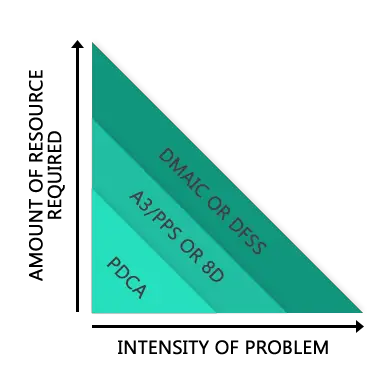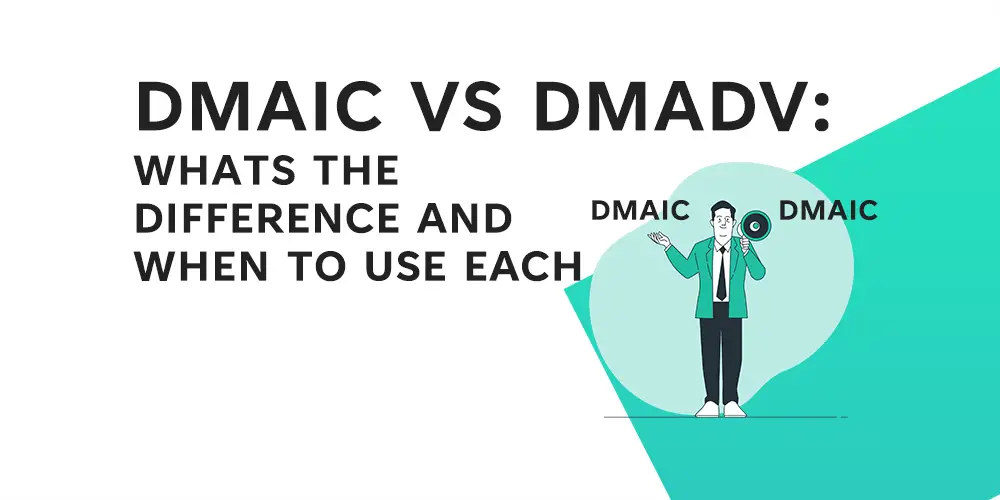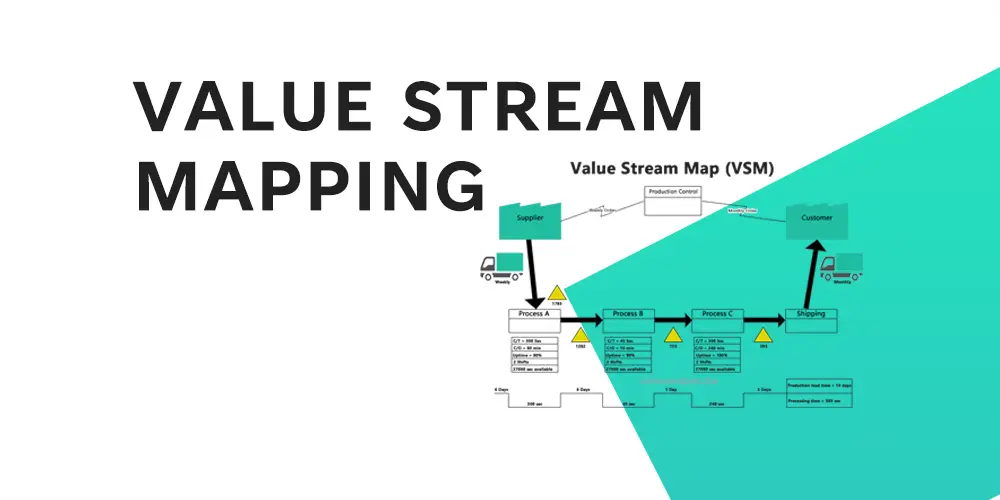There are several methodologies available to businesses for process improvement and quality management. DMAIC and DMADV are two of the most popular. Lean Six Sigma employs both of these methodologies to achieve continuous improvement in an organization’s processes. There are, however, significant differences between the two that can influence which methodology is best suited for a specific project or problem. In this blog post, we will discuss the differences between DMAIC and DMADV and when to use each methodology. You’ll have a better understanding of how these methodologies work and which one is best for your specific needs by the end of this post.
Continuous Improvement Methodologies

There are a variety of improvement methodologies available in Lean and Six Sigma, depending on the needs of the project and the complexity of the problem. PDCA (Plan, Do, Check, Act), 8D (Eight Disciplines), A3 (A3 Problem Solving), DMAIC, and DMADV are some of these methodologies.
PDCA is a problem-solving methodology that is used to continuously improve processes. In a cycle, it entails planning, implementing, testing, and acting on a solution. This methodology is often used for small-scale process improvements.
8D is a structured problem-solving methodology for identifying, correcting, and preventing problems. It consists of eight steps: problem identification, containment, root cause analysis, corrective actions, and preventive measures. This method is frequently used in the manufacturing and engineering industries.
A3 is a problem-solving methodology that uses a single page to document and communicate a problem and its solution. It entails identifying the problem, analysing data, developing countermeasures, and putting the solution into action. This methodology is frequently employed in Lean organisations.
DMAIC and DMADV are two of the most popular Six Sigma methodologies. DMAIC is used for process improvement, whereas DMADV is used for the design of new processes or products. This blog post goes into great detail about these methodologies.
It should be noted that each methodology has its own use case and can be effective in a variety of situations. The appropriate methodology should be chosen based on the project’s needs, the complexity of the problem, and the resources available. Understanding the advantages and disadvantages of each methodology can assist organisations in selecting the best approach to improve their processes and achieve their objectives.
DMAIC Methodology
Overview of DMAIC Methodology
DMAIC is a problem-solving methodology that is commonly used in Six Sigma and other process improvement initiatives. DMAIC is an acronym that stands for Define, Measure, Analyze, Improve, and Control. It is a methodical approach to identifying and resolving problems, as well as reducing defects and improving processes. The DMAIC methodology is data-driven and focuses on producing measurable and long-term results.

Define Phase
The Define phase is the first step in the DMAIC methodology. During this phase, the project team defines the problem or opportunity for improvement, determines the project scope, and establishes project goals and objectives. In addition, the team develops a project charter that outlines the project’s purpose, scope, goals, and expected outcomes. The Define phase establishes the foundation for the remainder of the DMAIC methodology and ensures that the project team is on the same page regarding the project’s goals and objectives.
Measure Phase
The DMAIC methodology’s second step is the Measure phase. The project team gathers data on current process performance and identifies key process variables that influence the process’s output during this phase. To measure and analyse the data collected, the team employs a variety of statistical tools and techniques. The Measure phase establishes a baseline for the current performance of the process and identifies areas for improvement.
Analyse Phase
The third step in the DMAIC methodology is to analyse. The project team analyses the data collected in the Measure phase and determines the root causes of the problems or issues identified in the Define phase during this phase. To identify the root causes, the team employs a variety of tools and techniques such as Pareto charts, fishbone diagrams, and statistical analysis. The Analyze phase helps the team identify potential solutions and provides a deeper understanding of the process.
Improve Phase
The fourth step in the DMAIC methodology is the Improve phase. The project team identifies potential solutions to the root causes identified in the Analyze phase during this phase. The team assesses potential solutions and chooses the best one for implementation. The solution is then implemented and tested to ensure that it addresses the root causes and improves process performance.
Control Phase
The fifth and final step in the DMAIC methodology is the Control phase. The project team establishes controls in this phase to ensure that the process remains under control and that the improvements made in the Improve phase are sustained. The team also creates a monitoring and measurement plan to track the performance of the process and identify any potential issues. The Control phase ensures that the process is stable and long-lasting.
What to use DMAIC
DMAIC methodology is best suited for projects that aim to improve an existing process or solve a problem that is already occurring. DMAIC is data-driven and aims to achieve measurable and long-term results. DMAIC is an effective methodology for organisations seeking to reduce defects, improve process efficiency, and boost customer satisfaction. DMAIC methodology can be applied to a wide range of industries, including manufacturing, healthcare, finance, and service industries.
DMADV Methodology
Overview of DMADV Methodology
Another problem-solving methodology used in Six Sigma and other process improvement initiatives is DMADV. DMADV is an acronym that stands for Define, Measure, Analyze, Design, and Verify. DMADV is a methodical approach to developing a new process, product, or service that meets or exceeds customer expectations. DMADV methodology is also data-driven, with a focus on achieving measurable and long-term results.

Define Phase
The Define phase is the first step in the DMADV methodology. The project team defines the project goals and objectives, identifies customer requirements, and develops a project charter during this phase. In addition, the team identifies any project constraints and risks. The Define phase ensures that the team is on the same page regarding the project’s purpose and objectives.
Measure Phase
The DMADV methodology’s second step is the Measure phase. The project team measures and collects data on the customer requirements identified in the Define phase during this phase. The team analyses the data using various statistical tools and techniques to identify the critical-to-quality (CTQ) characteristics of the product or service. The Measure phase establishes a foundation for designing the new process, product, or service.
Analyze Phase
The third step in the DMADV methodology is the Analyze phase. In this phase, the project team analyses the data collected in the Measure phase and identifies potential design solutions. To identify potential design solutions and assess their feasibility, the team employs a variety of tools and techniques, including QFD (Quality Function Deployment) and FMEA (Failure Mode and Effect Analysis). The Analyze phase ensures that the design solutions meet the customer requirements and provides a detailed understanding of those requirements.
Design Phase
The fourth step in the DMADV methodology is the Design phase. The project team creates a new process, product, or service that meets or exceeds the customer requirements identified in the previous phases during this phase. The Analyze phase design solutions are used by the team to create a detailed design that includes technical specifications, process flow diagrams, and design validation plans. The Design phase ensures that the new process, product, or service meets the needs of the customer and is practical to implement.
Verify Phase
The DMADV methodology concludes with the Verify phase. During this phase, the project team validates the feasibility and validity of the design through pilot testing and validation. The team also creates an implementation plan and ensures that the new process, product, or service meets the needs of the customer. The Verify phase ensures that the new process, product, or service is long-lasting and achieves the desired results.
When to use DMADV
The DMADV methodology is best suited for projects involving the development of a new process, product, or service that meets or exceeds customer expectations. DMADV is also data-driven and committed to achieving measurable and long-term results. DMADV is a useful methodology for organisations looking to develop new products, services, or processes that will give them a market advantage. DMADV methodology can be used in a variety of industries, including manufacturing, healthcare, finance, and service.
DMAIC vs DMADV: Key Differences
While both DMAIC and DMADV are problem-solving methodologies used in Six Sigma and other process improvement initiatives, they have significant differences.
Goals and Objectives
DMAIC’s primary goal is to improve an existing process that is not meeting customer expectations or performing optimally. To achieve measurable and sustainable improvements, DMAIC focuses on identifying and eliminating the root causes of process problems.
DMADV, on the other hand, seeks to create a new process, product, or service that meets or exceeds customer expectations. DMADV is concerned with identifying and designing solutions that will satisfy the critical-to-quality (CTQ) characteristics of the new process, product, or service.
Phases and Tools
Although both methodologies have five phases, the tools and techniques used in each phase vary.
The DMAIC methodology consists of the phases Define, Measure, Analyze, Improve, and Control. The Define phase is concerned with defining the project’s goals and objectives, whereas the Measure phase is concerned with gathering and analysing data about the current process. The Analyze phase identifies the root causes of process problems, while the Improve phase develops and implements solutions to those problems. Finally, the Control phase is used to monitor and maintain the gains.
The DMADV methodology consists of the phases Define, Measure, Analyze, Design, and Verify. The DMAIC methodology’s Define and Measure phases are similar. However, during the Analyze phase, the emphasis is on
Data Requirements
Both methodologies rely on data, but the type of data required varies.
To identify and analyse the root causes of problems, DMAIC methodology requires data from the current process. Data on process inputs and outputs, defects, and other quality metrics are included. Control charts, histograms, and Pareto charts are among the statistical tools used by DMAIC.
DMADV methodology necessitates data on customer needs and expectations in order to design a new process, product, or service that meets those needs. This includes information about customer wants, needs, and preferences, as well as market research data. DMADV also makes use of tools like QFD (Quality Function Deployment) and FMEA (Failure Mode and Effect Analysis).
Application
These methodologies are also used in different ways.
DMAIC methodology is best suited for improving existing processes that do not meet customer requirements or perform poorly. DMAIC is widely used in the manufacturing, healthcare, finance, and service sectors.
DMADV methodology is ideal for developing new processes, products, or services that meet or exceed customer expectations. DMADV is widely used in product development, engineering, and design.
Overall, while DMAIC and DMADV are similar, they are used in different contexts and necessitate different approaches and tools. To achieve the desired results, it is critical to select the appropriate methodology for the project.
Conclusion
To summarise, DMAIC and DMADV are both powerful methodologies that can assist organisations in improving their processes and products. DMAIC is a good tool for improving existing processes, whereas DMADV is good for designing new processes or products. The appropriate methodology should be chosen based on the project’s needs, the complexity of the problem, and the resources available.
We discussed the key differences between DMAIC and DMADV, as well as their respective phases and tools, in this blog post. We also examined the data requirements for each methodology and when to employ them.
While there are other improvement methodologies such as PDCA, 8D, and A3, DMAIC and DMADV are two of the most commonly used methodologies in Six Sigma. Understanding these methodologies can help organisations make informed decisions about which approach to use to improve their processes and achieve their goals.
Overall, DMAIC and DMADV are powerful tools that can assist organisations in achieving their goals. Organizations can choose the best approach for their specific needs and improve their overall business performance by understanding the differences between these methodologies.
References
- Lynch, D.P., Bertolino, S. and Cloutier, E., 2003. How to scope DMAIC projects. Quality progress, 36(1), pp.37-41.
- Selvi, K. and Majumdar, R., 2014. Six sigma-overview of DMAIC and DMADV. International Journal of Innovative Science and Modern Engineering, 2(5), pp.16-19.








